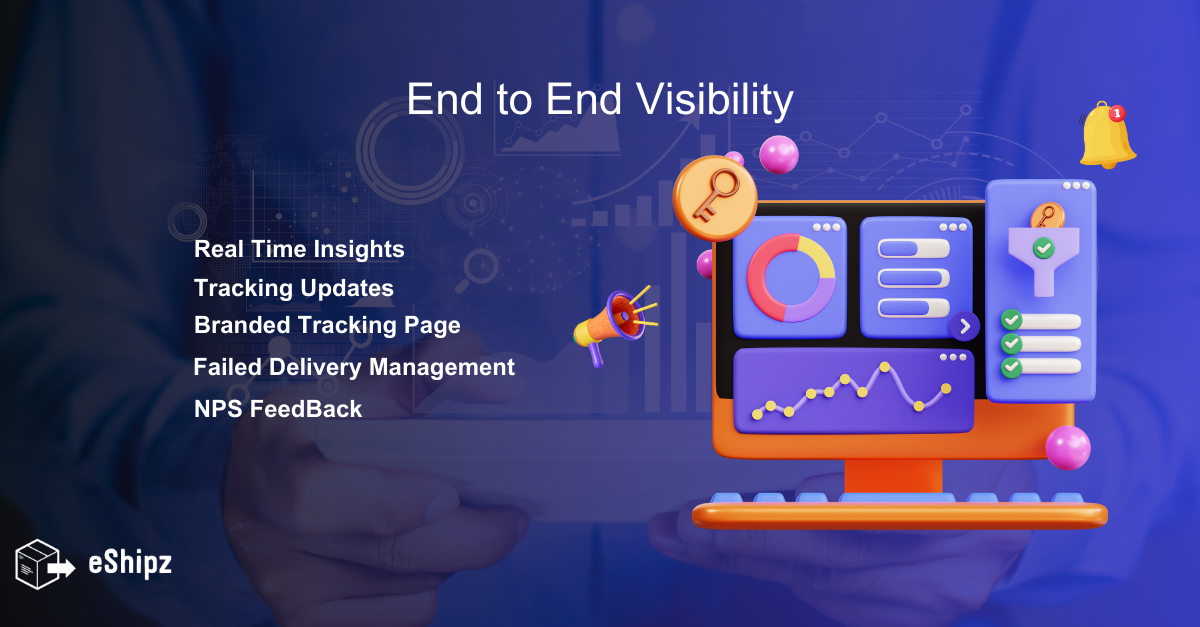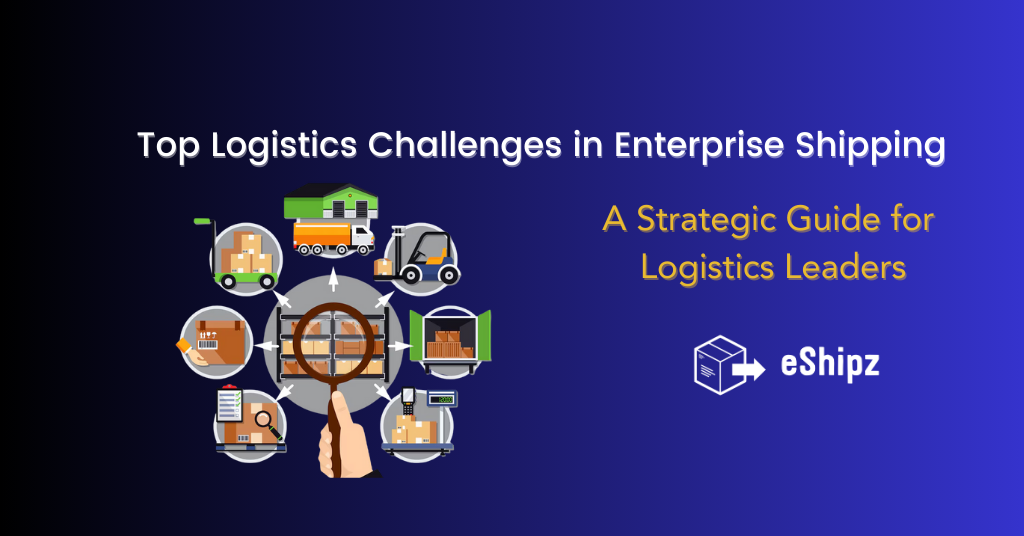For logistics leaders, managing a streamlined, cost-effective, and resilient supply chain is key to driving growth in a competitive market. From handling soaring shipping costs to ensuring real-time visibility and compliance, enterprise logistics is riddled with challenges. But with the right strategies, you can turn these challenges into opportunities for operational excellence and customer satisfaction. Here, we’ll explore the top logistics challenges enterprises face and actionable solutions to help you deliver optimized, cost-effective shipping operations.
1. Rising Shipping Costs: Strategies for Cost Control and Efficiency
As shipping rates increase due to fuel costs, regulatory demands, and supply chain disruptions, controlling logistics expenses has become a top priority for logistics heads. Rising costs can quickly impact profitability, making it essential to find ways to balance efficient shipping with budget constraints.
Solution: Implement a multi-carrier platform such as eShipz and use advanced shipping platforms like eShipz to compare carrier rates in real time, select the most cost-effective options, and access bulk discounts. Negotiating long-term carrier contracts can also lead to lower rates. By leveraging these tactics, logistics heads can gain better control over shipping costs, improve operational efficiency, and protect the bottom line.
2. Managing Complex Supply Chains: Achieving Full Visibility Across Operations
Enterprise supply chains are often complex, involving multiple suppliers, manufacturing hubs, warehouses, and distribution channels. Without full visibility, it becomes challenging to make informed decisions, predict delays, or identify bottlenecks that could impact delivery times.
Solution: Invest in a logistics management platform that provides end-to-end visibility, like eShipz, which integrates seamlessly with ERP systems and offers real-time data on shipments, inventory, and order fulfilment. This visibility helps logistics heads proactively address delays, improve coordination across teams, and make data-driven decisions that enhance efficiency and customer satisfaction.
3. Seasonal Peaks and Demand Fluctuations: Preparing for Volatility with Demand Forecasting
Demand fluctuations—especially during peak seasons, promotions, or unexpected surges—can disrupt supply chain operations, leading to stockouts or delays in order fulfilment.
Solution: Leverage demand forecasting tools that use historical data, predictive analytics, and AI to predict demand shifts accurately. For added flexibility during peak seasons, consider working with 3PLs to handle excess volume without overloading your core logistics team. This approach ensures that inventory levels are managed effectively, and customer satisfaction remains high, even during periods of increased demand.

4. Compliance and Documentation: Simplifying Global Shipping for Fast, Compliant Deliveries
For enterprises operating across borders, navigating complex compliance requirements and handling documentation can be a time-consuming challenge. Each country has unique regulations and documentation needs, and non-compliance can lead to fines, delays, or even seized goods.
Solution: Opt for a logistics platform with built-in compliance and documentation modules, like eShipz, to automate documentation and manage country-specific requirements effortlessly. With automated customs documentation and compliance alerts, you can avoid costly mistakes, reduce processing times, and expedite international shipments, ensuring smooth cross-border operations.
5. Meeting High Customer Expectations: Creating a Seamless Customer Experience
In today’s competitive landscape, customers expect transparency, accurate tracking, and fast deliveries. Failure to meet these expectations can impact customer loyalty and brand reputation.
Solution: Prioritize a customer-centric approach by providing real-time tracking and proactive notifications on shipment status. Platforms like eShipz allow customers to access tracking information easily, while automated notifications keep them informed every step of the way. Additionally, offering flexible delivery options, such as same-day or two-day shipping, can cater to different customer needs and improve overall satisfaction.
6. Preventing Shipment Damage and Loss: Enhancing Quality Control and Risk Management
Shipment damage and loss not only affect your company’s bottom line but also risk eroding customer trust. For logistics leaders, minimizing these incidents is crucial to maintaining efficiency and protecting the brand.
Solution: Invest in quality packaging and choose reliable carriers to reduce the chances of damage in transit. Real-time tracking technology, like GPS and IoT sensors, enables your team to monitor high-value shipments, identify risks early, and take immediate corrective actions. For high-value items, consider purchasing insurance to further mitigate potential losses. Together, these strategies minimize risk and contribute to a smoother logistics process.
7. Returns Management: Streamlining Reverse Logistics to Cut Costs and Improve Efficiency
Returns management is a critical yet often overlooked aspect of logistics, especially in industries with high return rates, such as e-commerce and retail. An inefficient returns process can lead to warehouse congestion, increased handling costs, and customer dissatisfaction.
Solution: Develop a dedicated returns management strategy that leverages automated returns tracking, clear return policies, and dedicated processing centers. Platforms like eShipz can streamline the returns process by creating return labels with outbound shipments and tracking each return, allowing for quick refunds and better warehouse organization. Efficient returns management reduces costs and ensures a positive customer experience.

8. Data Management and Analytics: Leveraging Data for Informed Logistics Decisions
Enterprises generate massive amounts of data across supply chain touchpoints. However, data silos and inconsistent reporting make it difficult to gain insights needed to optimize logistics.
Solution: Consolidate data across all logistics channels using a centralized data platform that can analyze performance metrics and reveal patterns for future improvements. Platforms like eShipz offer advanced data analytics capabilities, enabling logistics heads to make informed decisions based on real-time data. This consolidated approach facilitates accurate forecasting, improves process transparency, and highlights areas where efficiency gains can be achieved.
9. Optimizing Warehouse and Inventory Management: Reducing Costs Through Efficient Storage
Efficient warehouse and inventory management are essential for smooth logistics operations, but they can be difficult to achieve on a large scale. Poor organization and inventory mismanagement lead to higher labor costs and delayed order fulfilment.
Solution: Implement a Warehouse Management System (WMS) with automated inventory tracking, barcode scanning, and RFID tagging to improve accuracy and efficiency. Regularly auditing inventory and optimizing layout designs for reduced transit time can further enhance efficiency. eShipz can help integrate your WMS with real-time logistics data, making it easier to adjust inventory levels based on demand forecasts and streamline overall warehouse operations.
10. Real-Time Collaboration: Ensuring Seamless Communication Among Stakeholders
In enterprise logistics, multiple stakeholders—including suppliers, carriers, and internal teams—must work together seamlessly to maintain an efficient supply chain. A lack of collaboration often results in miscommunication, delays, and increased operational costs.
Solution: Foster a collaborative environment by using a cloud-based logistics platform like eShipz, which enables real-time communication, shared tracking, and updates for all parties involved. Centralized communication enhances transparency, aligns team efforts, and reduces the risk of errors, making it easier for logistics heads to maintain a synchronized and efficient logistics process.
Final Thoughts
Overcoming these logistics challenges is essential for logistics heads to drive efficiency, meet customer expectations, and maintain a competitive edge in today’s market. By leveraging data-driven tools, adopting multi-carrier strategies, and improving visibility across supply chains, logistics leaders can create a robust shipping framework that supports enterprise growth.
With platforms like eShipz, enterprise logistics can be transformed into a seamless operation that not only meets today’s logistics demands but also sets the foundation for scalable, future-ready logistics. Explore how eShipz can help your organization tackle these challenges and elevate your logistics strategy.

